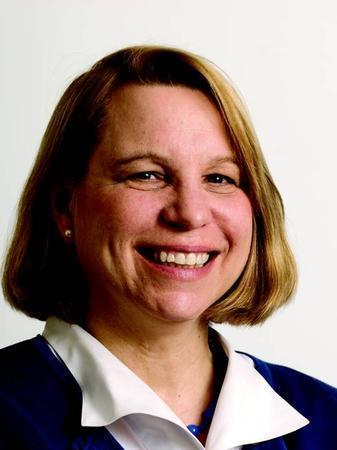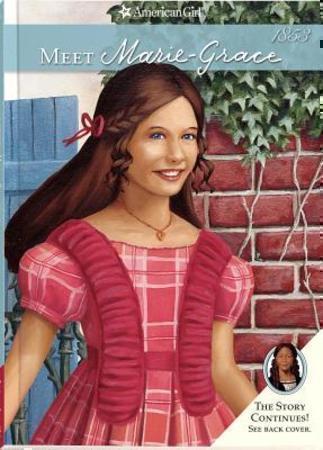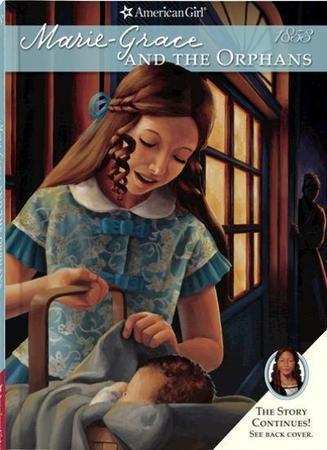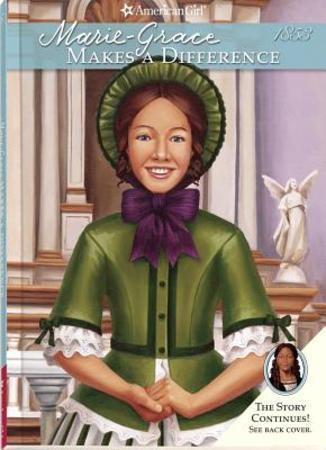
Sarah Masters Buckey is the author of the Marie-Grace American Girl books. Below is a complete transcript of her interview with Cracking the Cover.
Have you always wanted to write? Why?
When I was little, I’d page through Golden Books, wishing I could understand the writing underneath the pictures. When I finally learned to read, I felt as if I’d unlocked a code. As a child, I read anything I could find — from National Geographics and old Hardy Boys novels to comics and cereal boxes. The first things I wrote were birthday poems for my parents and my brother and sister – the poems were silly, but my family liked them, so that was all the encouragement I needed.
Why write for young readers?
I first began making up stories for children when I was a teenager and I babysat for my niece. She’d always ask me for “Just one more story!” When I had my own children, I made up stories for them. I discovered that I loved creating adventures for fictional characters.
Do you have any rituals? Do you write all day?
It’s not a ritual, but when I’m outlining a story, I like to make notes on yellow index cards. When I have an idea how the plot should work, I’ll arrange the cards on a table. That way, I can look at the plot and rearrange or re-write cards as needed.
I wish I was one of those people who could write all day, but I can only concentrate for a few hours at a time — and then I need to take a break. I’ll often work in the evenings, though, and sometimes, when I’m not at my computer, I’ll get my best ideas. I’ll be walking my dog or peeling vegetables for dinner, and I’ll finally figure out how to solve a problem in a story.
How did you get involved in with American Girl series? What was your first exposure to it?
My older daughter introduced me to American Girl when she was in third grade. She’d pour over the American Girl catalog and point out the dolls she liked and the stories she wanted to read. (She’s in graduate school now, so that was a while ago!) For Christmas one year, I wrote her a short story about a girl growing up on a farm in the 1800’s, and later, I submitted the story to American Girl magazine.
American Girl didn’t use that story, but later, they asked me if I’d like to try writing a short story featuring the historical character, Samantha. Since then, I’ve written a story and three mysteries for Samantha, as well as eight other books published by American Girl.
 Where did Marie-Grace’s character come from? How did she evolve after comparing notes with Denise?
Where did Marie-Grace’s character come from? How did she evolve after comparing notes with Denise?
I’d always wanted to write about a young girl who was shy, so I knew from the beginning that Marie-Grace would be brave in many ways – but often hesitant to speak up for herself. Fortunately, Denise’s character, Cécile, is outspoken and confident, so the girls work really well together – and each brings out the best in each other.
This is the first time two American Girls have been introduced/paired together. What were the challenges? The highlights?
Denise and I faced the challenges of the dual stories early on. When we began, we had to plot the story arcs both for our individual characters and for the yellow fever epidemic in New Orleans. It was a challenge to interweave the stories so that events could be told from both views – without either skipping important information or becoming repetitive.
But once we decided on the plot outlines, it was great to have the differing points of view. I think combining the girls’ perspectives gives a richer view of history and the yellow fever epidemic in New Orleans.
How hard or easy was it for you to incorporate French into the books?
Like Marie-Grace at the beginning of the series, I don’t speak French. But my children all studied French in school, so I could ask them to help me translate phrases. During the editing process, an expert also checked to be sure that the French used in the book accurately reflected how the language was spoken in New Orleans during the 1850’s.
Was the series originally planned to feature two girls and two writers? Describe the collaborative process with Denise.
I’m not sure when plans for the series began. But when I started working on the series, I knew it would feature two girls and two authors.
Denise and I first met at American Girl during the summer of 2008. Neither of us had ever written a series with a co-author before, but luckily we worked together really well from the beginning. Over a few days in Wisconsin, we shared our thoughts for the series – bouncing ideas back and forth across the table like ping pong balls. “What if…” “ How about?” “Maybe we could try….”
It was an intense process, but fun, and during those days we planned the overall plot arc, along with outlines of the first four books. Afterwards, we each worked in our own homes – Denise in New Jersey and me in New Hampshire. But we could email or call each other if questions came up or we wanted to bounce around more ideas. As we worked, we got to know each other better — just as our characters got to know each other, too, –and we became friends. We met again at American Girl in 2009 to plot the last two books – and we finished the books in the fall of 2010.
 How much research planning went into the books?
How much research planning went into the books?
Lots! We researched before we started writing, and the research continued all through the writing process, as questions kept coming up. I looked at many sources for information about New Orleans and the 1853 yellow fever epidemic –- guidebooks, museums, histories, and websites as well as primary sources such as diaries, old medical books, and newspapers from New Orleans in 1853. I also made two trips to New Orleans. On each visit I tried to imagine what the city was like in 1853 – and what Marie-Grace would have seen and experienced. Finally, experts in history of the area reviewed the manuscripts and gave helpful advice and information.
What sets historical fiction apart? And what makes New Orleans in 1853 special?
Historical fiction has a double job – to portray history accurately and to engage readers in an exciting story. I think that books that do this well can have a lasting impact. For example, Johnny Tremain taught me more about the American Revolution than my fourth grade history textbook did.
In 1853, New Orleans was a major port, a business center, and a very cosmopolitan city. Many immigrants were arriving every day from Europe, and people were traveling to New Orleans from all over the U.S. and the Caribbean islands. There had always been yellow fever in the area, but during 1853, the epidemic that struck the city was devastating. Before the epidemic ended, about 10,000 people in New Orleans died of the disease.
What is your own experience with New Orleans?
I’ve never lived in New Orleans, but I’m fascinated by the city’s history and culture. I set my first mystery for American Girl, The Smuggler’s Treasure, in New Orleans during the War of 1812.
 In a time when it seems that children are growing up faster and faster, what is it about your books and the American Girl books in general that appeal to girls?
In a time when it seems that children are growing up faster and faster, what is it about your books and the American Girl books in general that appeal to girls?
First, I think girls like the books because they’re fun and exciting adventures – and reading should be fun! The books also encourage girls to believe in themselves and their own abilities. Both girls and boys are equally valued in the stories – and that’s very important. Finally, girls are not treated as “pre-teens” or “pre” anything – they are respected as valuable people in their own right.
In Marie-Grace you’ve not only created a story but a whole world that has been expanded by others into dolls, clothes, games and accessories. What has that experience been like?
The first time I held a Marie-Grace doll, I couldn’t believe it. It was amazing to see a character that I had seen first in my imagination now transformed into a doll.
American Girl is more than 25 years old. Did you feel any pressure to live up to your books’ predecessors?
Actually, I like how each of the historical characters is different. I’ve written stories for Samantha, Molly, and Kit, so I know those characters well, and each girl has her own strengths and challenges. I’m glad that the characters Denise and I created are also distinct individuals with their own backgrounds and personalities – and their own voices, too.
Did you have a favorite book or book that really resonated with you as a young reader?
There were so many great books that I loved! But to name a few – The Little House on the Prairie series has wonderful descriptions and I enjoyed reading the books to my own children. I also loved A Little Princess, The Lion, the Witch and the Wardrobe series, the Nancy Drew and Hardy Boys books, and, when I was a little older, Jane Eyre.
